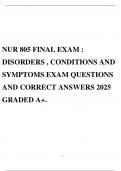NUR 805 FINAL EXAM :
DISORDERS , CONDITIONS AND
SYMPTOMS EXAM QUESTIONS
AND CORRECT ANSWERS 2025
GRADED A+.
,1. Recessive Genes: The allele whose effects are hidden is said to be this. (from the Latin for hiding)
2. Dominant Genes: The allele whose effects are observable is said to be this.
3. Allergy: Originally denoted both facets of the immune response; immunity, which is beneficial and hypersensitivity
which is harmful. Now it has come to mean the deleterious effects of hypersensitivity to environmental antigens, and
immunity means the protective responses to antigens expressed by disease-causing agents.
4. Hypersensitivity: An altered immunologic response to an antigen that results in disease or damage to the host.
5. Types of Hypersensitivity: Type 1- Immunoglobulin E (IgE)-mediated Type 2- Tissue-specific
Type 3- Immune Complex-mediated Type 4- Cell-
mediated
6. Type 1 Immunoglobulin E (IgE)-mediated reaction: Rate of Development: Im- mediate
Class of Antibody Involved: IgE
Principle Effector Cells involved: Mast Cells Complement
Participation: No
Examples of Disorders: Seasonal Allergic Rhinitis
7. Type 2 Tissue Specific reaction: Rate of Development: Immediate Class of Antibody Involved:
IgG and IgM
Principle Effector Cells involved: Macrophages in tissues Complement Participation: Frequently
Examples of Disorders: Autoimmune thrombocytopenic purpura, Grave's disease, autoimmune hemolytic anemia
8. Type 3 Immune complex-mediated reaction: Rate of Development: Immediate Class of Antibody Involved: IgG and
IgM
Principle Effector Cells involved: Neutrophils Complement
Participation: Yes
Examples of Disorders: Systemic Lupus Erythematosus
9. Type 4 Cell-mediated reaction: Rate of Development: Delayed Class of Antibody Involved:
None
Principle Effector Cells involved: Lymphocytes, macrophages Complement Participation: No
Examples of Disorders: Contact sensitivity to poison ivy and metals (jewelry)
10. Clinical Manifestations of Systemic Lupus Erythematosus (SLE): 1. Facial Rash confined to the cheeks (malar
rash)
2. Discoid Rash(raised patches, scaling)
3. Photosensivity (skin rash developed as a result of exposure to sunlight)
,4. Oral or nasopharyngeal ulcers
5. Nonerosive arthritis of at least 2 peripheral joints
6. Serositis (pleurisy, pericarditis)
7. Renal Disorder (proteinuria of 0.5g/day or cellular casts)
8. Neurologic disorders (seizures or psychosis)
9. Hematologic disorders (hemolytic anemia, leukopenia, lymphopenia, or thrombo- cytopenia)
10. Immunologic disorders (positive lupus erythmatosus [LE] cell preparation, anti-double-stranded DNA, anti-
Smith [Sm] antigen, false-positive serologic test test for syphilis, or antiphospholipid antibodies [anticardolipin
antibody or lupus anticoagulat])
11. Presence of antinuclear antibody (ANA)
11. Purpose of Vaccinations: To induce active immunologic protection before ex- posure to the risks of infection.
12. Pernicious Anemia (PA): Chacterized by usually large in size, thickness and volume but the hemoglobin is normal.
It is caused by a B12 deficiency, which leads to an issue in nuclear maturation and DNA synthesis in erythrocytes.
13. Symptoms of Pernicious Anemia: Early symptoms: Infections, mood swings, and GI, cardiac and kidney ailments.
When Hgb decrease significantly (7-8) the symptoms are weakness, fatigue, paraestheisas of the feet and fingers,
difficulty in walking, loss of appetites, abdominal pains, weight loss, and a sore tongue that is smooth and beef red
secondary to atrophic gastritis. Hepatomegaly, indicating right-sided heart failure, in the elderly and splenomegaly is
nonpalable. There can also be neurological deficient.
14. Lab values of Pernicious Anemia: Hemoglobin- low Hematocrit- low
Reticulocyte Count-low
Mean Corpuscular volume- high Plasma Iron- High
Total Iron-binding capacity- Normal Ferritin- High
Serum B12- Low Folate-
Normal Bilirubin- Slightly high
Free erythrocyte protoporphin- Normal Transferrin-
Slightly high
15. Iron Deficiency Anemia: This is characterized by abnormally small erythro- cytes that contain abnormally
reduced amount of hemoglobin. This is caused by inadequate dietary intake and excessive blood loss.
, 16. Symptoms of Iron Deficiency Anemia: Early symptoms include fatigue, weak- ness, shortness of breath, and pale
earlobes, palms, and conjunctivae. The finger- nails become brittle, thin, coarsely ridged and "spoon-shaped" or concave.
Burning mouth syndrome, tongue papillae atrophy, and dryness a the corner of the eyes.
17. Lab values for Iron Deficiency Anemia: Hemoglobin- low Hematocrit- low
Reticulocyte Count-normal or low or high Mean Corpuscular
volume- low
Plasma Iron- low
Total Iron-binding capacity- high Ferritin- low
Serum B12- normal Folate-
Normal Bilirubin- high
Free erythrocyte protoporphin- increased or Normal Transferrin- high
18. Aplastic Anemia (AA): Critical condition characterized by pancytopenia, a re- duction or absence of all three blood
cell types, resulting from failure or suppression of the bone marrow to produce adequate amounts of blood cells.
19. Symptoms of Aplastic Anemia: Hypoxemia, pallor (occasionally with a brown- ish, pigmentation of the skin),
weakness along with fever and dyspnea with rapidly developing signs of hemorrhage.
Late manifestations: Ulceration of the mouth & pharynx, or low-grade cellulitis of neck.
20. Lab values for Aplastic Anemia: Hemoglobin- low or normal Hematocrit- low or normal
Reticulocyte Count-low
Mean Corpuscular volume- normal or slightly high Plasma Iron- high
Total Iron-binding capacity- normal Ferritin-
normal
Serum B12- normal Folate-
Normal Bilirubin- high
Free erythrocyte protoporphin- Normal Transferrin- high
21. Hemolytic Anemia: A result of excessive destruction of erythrocytes and may be acquired or heredity. Of the
acquired forms, autoimmune reaction and drug-in- duced hemolysis are the most common.




